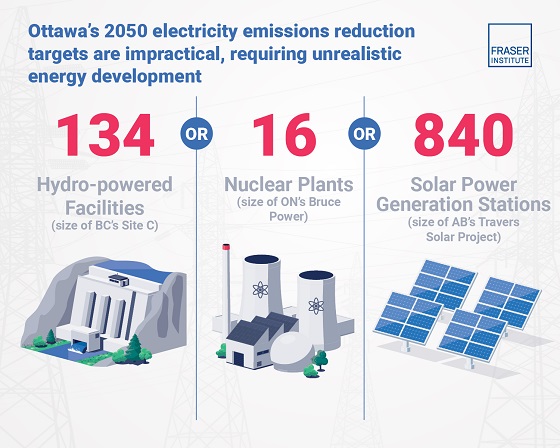Energy
Canada must build 840 solar-power stations or 16 nuclear power plants to meet Ottawa’s 2050 emission-reduction target

From the Fraser Institute
The federal government’s plan to eliminate greenhouse gas (GHG) emissions from electricity generation by 2050 is impossible in practical terms, finds a new study published today by the Fraser Institute, an independent, non-partisan Canadian public policy think-tank.
Due to population growth, economic growth and the transition to electrified transportation, electricity demand in Canada will increase substantially in coming years. “To meet existing and future electricity demand with low-emitting or zero-emitting sources within the government’s timeline, Canada would need to rapidly build infrastructure on a scale never before seen in the country’s history,” said Kenneth P.
Green, senior fellow at the Fraser Institute and author of Rapid Decarbonization of Electricity and Future Supply Constraints.
For example, to generate the electricity needed through 2050 solely with solar power, we’d need to build 840 solar-power generation stations the size of Alberta’s Travers Solar Project. At a construction time of two years per project, this would take 1,680 construction years to accomplish.
If we relied solely on wind power, Canada would need to build 574 wind-power installations the size of Quebec’s Seigneurie de Beaupre wind-power station. At a construction time of two years per project, this would take 1,150 construction years to accomplish.
If we relied solely on hydropower, we’d need to build 134 hydro-power facilities the size of the Site C power station in British Columbia. At a construction time of seven years per project, this would take 938 construction years to accomplish.
If we relied solely on nuclear power, we’d need to construct 16 new nuclear plants the size of Ontario’s Bruce Nuclear Generating Station. At a construction time of seven years per project, this would take 112 construction years to accomplish.
Currently, the process of planning and constructing electricity-generation facilities in Canada is often marked by delays and significant cost overruns. For B.C.’s Site C project, it took approximately 43 years from the initial planning studies in 1971 to environmental certification in 2014, with project completion expected in 2025 at a cost of $16 billion.
“When Canadians assess the viability of the federal government’s emission-reduction timelines, they should understand the practical reality of electricity generation in Canada,” Green said.
Decarbonizing Canada’s Electricity Generation: Rapid Decarbonization of Electricity and Future Supply Constraints
- Canada’s Clean Electricity Regulations (Canada, 2024a) require all provinces to fully “decarbonize” their electricity generation as part of the federal government’s broader “Net-Zero 2050” greenhouse gas emissions mitigation plan.
- Canada’s electricity demands are expected to grow in line with the country’s population, economic growth, and the transition to electrified transportation. Projections from the Canada Energy Regulator, Canadian Climate Institute, and Department of Finance estimate the need for an additional 684 TWh of generation capacity by 2050.
- If Canada were to meet this demand solely with wind power, it would require the construction of approximately 575 wind-power installations, each the size of Quebec’s Seigneurie de Beaupré Wind Farm, over 25 years. However, with a construction timeline of two years per project, this would equate to 1,150 construction years. Meeting future Canadian electricity demand using only wind power would also require over one million hectares of land—an area nearly 14.5 times the size of the municipality of Calgary.
- If Canada were to rely entirely on hydropower, it would need to construct 134 facilities similar in size to the Site C power station in British Columbia. Meeting all future demand with hydropower would occupy approximately 54,988 hectares of land—roughly 1.5 times the area of the municipality of Montreal.
- If Canada were to meet its future demand exclusively with nuclear power, it would need to construct 16 additional nuclear plants, each equivalent to Ontario’s Bruce Nuclear Generating Station.
- Meeting the predicted future electricity demand with these low/no CO2 sources will be a daunting challenge and is likely impossible within the 2050 timeframe.
Daily Caller
Paris Climate Deal Now Decade-Old Disaster


From the Daily Caller News Foundation
By Steve Milloy
The Paris Climate Accord was adopted 10 years ago this week. It’s been a decade of disaster that President Donald Trump is rightly trying again to end.
The stated purpose of the agreement was for countries to voluntarily cut emissions to avoid the average global temperature exceeding the (guessed at) pre-industrial temperature by 3.6°F (2°C) and preferably 2.7°F (1.5°C).
Since December 2015, the world spent an estimated $10 trillion trying to achieve the Paris goals. What has been accomplished? Instead of reducing global emissions, they have increased about 12 percent. While the increase in emissions is actually a good thing for the environment and humanity, spending $10 trillion in a failed effort to cut emissions just underscores the agreement’s waste, fraud and abuse.
As a nonprofit, we are dependent on the generosity of our readers.
Please consider making a small donation of any amount here.
Thank you!
But wasting $10 trillion is only the tip of the iceberg.
The effort to cut emissions was largely based on forcing industrial countries to replace their tried-and-true fossil fuel-based energy systems with not-ready-for-prime-time wind, solar and battery-based systems. This forced transition has driven up energy costs and made energy systems less reliable. The result of that has been economy-crippling deindustrialization in former powerhouses of Germany and Britain.
And it gets worse.
European nations imagined they could reduce their carbon footprint by outsourcing their coal and natural gas needs to Russia. That outsourcing enriched Russia and made the European economy dependent on Russia for energy. That vulnerability, in turn, and a weak President Joe Biden encouraged Vladimir Putin to invade Ukraine.
The result of that has been more than one million killed and wounded, the mass destruction of Ukraine worth more than $500 billion so far and the inestimable cost of global destabilization. Europe will have to spend hundreds of billions more on defense, and U.S. taxpayers have been forced to spend hundreds of billions on arms for Ukraine. Putin has even raised the specter of using nuclear weapons.
President Barack Obama unconstitutionally tried to impose the Paris agreement on the U.S. as an Executive agreement rather than a treaty ratified by the U.S. Senate. Although Trump terminated the Executive agreement during his first administration, President Joe Biden rejoined the agreement soon after taking office, pledging to double Obama’s emissions cuts pledge to 50 percent below 2005 levels by 2030.
Biden’s emissions pledge was an impetus for the 2022 Inflation Reduction Act that allocated $1.2 trillion in spending for what Trump labeled as the Green New Scam. Although Trump’s One Big Beautiful Bill Act reduced that spending by about $500 billion and he is trying to reduce it further through Executive action, much of that money was used in an effort to buy the 2024 election for Democrats. The rest has been and will be used to wreck our electricity grid with dangerous, national security-compromising wind, solar and battery equipment from Communists China.
Then there’s this. At the Paris climate conference in 2015, U.S. Secretary of State John Kerry stated quite clearly that emissions cuts by the U.S. and other industrial countries were meaningless and would accomplish nothing since the developing world’s emissions would be increasing.
Finally, there is the climate realism aspect to all this. After the Paris agreement was signed and despite the increase in emissions, the average global temperature declined during the years from 2016 to 2022, per NOAA data.
The super El Nino experienced during 2023-2024 caused a temporary temperature spike. La Nina conditions have now returned the average global temperature to below the 2015-2016 level, per NASA satellite data. The overarching point is that any “global warming” that occurred over the past 40 years is actually associated with the natural El Nino-La Nina cycle, not emissions.
The Paris agreement has been all pain and no gain. Moreover, there was never any need for the agreement in the first place. A big thanks to President Trump for pulling us out again.
Steve Milloy is a biostatistician and lawyer. He posts on X at @JunkScience.
Alberta
Alberta’s huge oil sands reserves dwarf U.S. shale

From the Canadian Energy Centre
By Will Gibson
Oil sands could maintain current production rates for more than 140 years
Investor interest in Canadian oil producers, primarily in the Alberta oil sands, has picked up, and not only because of expanded export capacity from the Trans Mountain pipeline.
Enverus Intelligence Research says the real draw — and a major factor behind oil sands equities outperforming U.S. peers by about 40 per cent since January 2024 — is the resource Trans Mountain helps unlock.
Alberta’s oil sands contain 167 billion barrels of reserves, nearly four times the volume in the United States.
Today’s oil sands operators hold more than twice the available high-quality resources compared to U.S. shale producers, Enverus reports.
“It’s a huge number — 167 billion barrels — when Alberta only produces about three million barrels a day right now,” said Mike Verney, executive vice-president at McDaniel & Associates, which earlier this year updated the province’s oil and gas reserves on behalf of the Alberta Energy Regulator.
Already fourth in the world, the assessment found Alberta’s oil reserves increased by seven billion barrels.
Verney said the rise in reserves despite record production is in part a result of improved processes and technology.
“Oil sands companies can produce for decades at the same economic threshold as they do today. That’s a great place to be,” said Michael Berger, a senior analyst with Enverus.
BMO Capital Markets estimates that Alberta’s oil sands reserves could maintain current production rates for more than 140 years.
The long-term picture looks different south of the border.
The U.S. Energy Information Administration projects that American production will peak before 2030 and enter a long period of decline.
Having a lasting stable source of supply is important as world oil demand is expected to remain strong for decades to come.
This is particularly true in Asia, the target market for oil exports off Canada’s West Coast.
The International Energy Agency (IEA) projects oil demand in the Asia-Pacific region will go from 35 million barrels per day in 2024 to 41 million barrels per day in 2050.
The growing appeal of Alberta oil in Asian markets shows up not only in expanded Trans Mountain shipments, but also in Canadian crude being “re-exported” from U.S. Gulf Coast terminals.
According to RBN Energy, Asian buyers – primarily in China – are now the main non-U.S. buyers from Trans Mountain, while India dominates purchases of re-exports from the U.S. Gulf Coast. .
BMO said the oil sands offers advantages both in steady supply and lower overall environmental impacts.
“Not only is the resulting stability ideally suited to backfill anticipated declines in world oil supply, but the long-term physical footprint may also be meaningfully lower given large-scale concentrated emissions, high water recycling rates and low well declines,” BMO analysts said.
-

 Business2 days ago
Business2 days agoMajor tax changes in 2026: Report
-

 Daily Caller1 day ago
Daily Caller1 day agoChinese Billionaire Tried To Build US-Born Baby Empire As Overseas Elites Turn To American Surrogates
-

 Digital ID1 day ago
Digital ID1 day agoCanada releases new digital ID app for personal documents despite privacy concerns
-

 Energy1 day ago
Energy1 day agoCanada’s sudden rediscovery of energy ambition has been greeted with a familiar charge: hypocrisy
-

 Alberta2 days ago
Alberta2 days agoSchools should go back to basics to mitigate effects of AI
-

 Daily Caller1 day ago
Daily Caller1 day agoTwo states designate Muslim group as terrorist
-

 International1 day ago
International1 day agoRussia Now Open To Ukraine Joining EU, Officials Briefed On Peace Deal Say
-

 Censorship Industrial Complex1 day ago
Censorship Industrial Complex1 day agoDeath by a thousand clicks – government censorship of Canada’s internet










